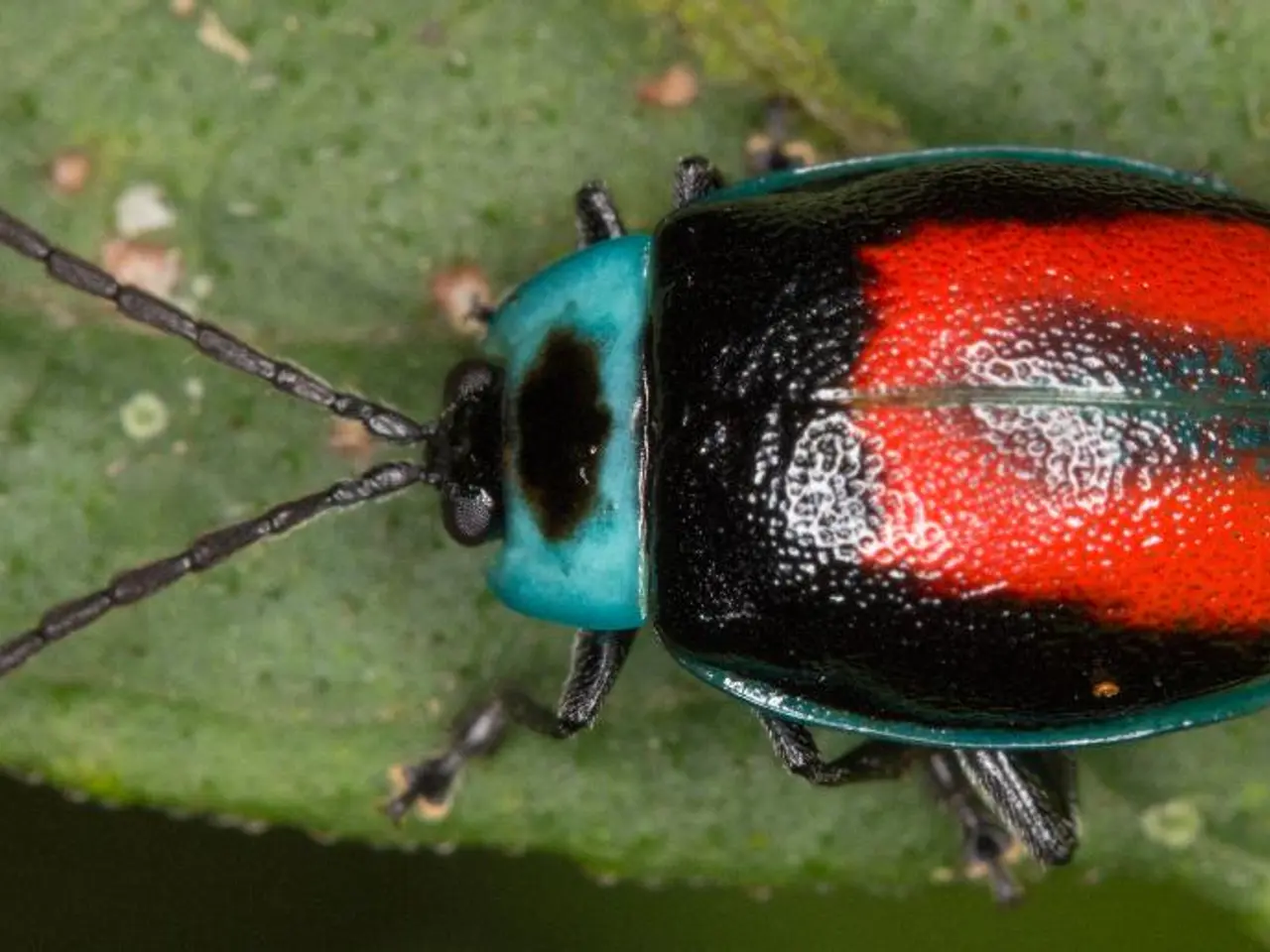Eliminating Cucumber Beetles: A Guide
In the world of gardening, one common pest that can pose a significant threat to cucurbit plants such as cucumbers, melons, and squash is the cucumber beetle. These small, winged insects can cause damage to leaves, flowers, and even fruit, and worse, they can carry diseases that are harmful to plants.
To help you identify these pests, there are two main types: the striped cucumber beetle, which is yellowish-orange with three black stripes, and the spotted cucumber beetle, which is greenish-yellow with twelve black spots. Both are about 1/4 inch long and have wings that allow them to fly between plants.
These beetles can transmit bacterial wilt, a serious disease with no cure, and mosaic viruses to cucurbit plants. Once infected, these diseases are incurable, making it crucial to prevent damage and population buildup early.
Fortunately, there are several methods to control cucumber beetles in a garden. One effective approach is hand-picking. Monitor plants closely, especially during the early growth stages, and physically remove any beetles found. Dropping them into soapy water will kill them.
Another method is the use of floating row covers to protect young plants from beetle damage early in the season. Remove covers when plants begin to flower for pollination.
Timing planting can also help. Plant cucurbits later (mid-June) to avoid peak emergence and feeding of overwintered beetles in late spring, reducing initial damage and beetle population buildup.
Garden hygiene is also essential. Keep the garden clean by mulching to deter egg laying, removing infected plants immediately, and cleaning up debris at the end of the summer to eliminate overwintering sites.
Encouraging beneficial insects like ladybugs, lacewings, soldier beetles, tachinid flies, parasitic nematodes, and braconid wasps that prey on cucumber beetles can also help control their population.
Planting repellent companions such as radishes, tansy, broccoli, calendula, nasturtiums, rue, dill, oregano, or asters can discourage beetles. Organic pesticides like neem oil, kaolin clay, or insecticidal soap can also be used when beetle populations are high.
Remember, cucumber beetles release a pheromone that attracts more beetles to feeding sites, so early control is vital to prevent population explosions. Because they can vector diseases with no cure, preventing their damage and population buildup early is critical.
By combining physical removal, cultural practices, biological control, and organic treatments, you can manage cucumber beetles sustainably in your garden. With a bit of effort, you can enjoy the taste of garden-fresh cucumbers despite their pest challenges.
Additional notes: In the spring, adult cucumber beetles feed on the cotyledons, stems, and emerging leaves of young plants. Spotted cucumber beetles resemble striped cucumber beetles but have 12 black spots on their wings. Remove all garden debris at the end of the summer to reduce shelter for overwintering cucumber beetles. Cucumber beetles can be found on cucurbit plants, including cucumbers, melons, and squash.
To confirm bacterial wilt, cut a symptomatic stem in half and hold the two ends together for about 10 seconds, then slowly pull them apart. A whitish, mucus-like string indicates bacterial wilt. Cucumbers and muskmelons are the most affected of the cucurbits by bacterial wilt.
Trap crops can attract cucumber beetles away from main cucurbit crops, allowing for their disposal and potential reduction of the pest population. Use organic insecticides like pyrethrum, neem, or kaolin clay as a last resort for controlling cucumber beetle infestations.
Plant attractive host plants like blue Hubbard squash, other buttercup squash, or zucchini two weeks before setting out desired cucurbits to encourage natural predators and provide additional protection.
- In a garden, both striped and spotted cucumber beetles, organism that can damage flowers, leaves, and fruit of cucurbit plants like cucumbers, melons, and squash, can be found.
- Encouraging pollinators such as ladybugs, lacewings, soldier beetles, tachinid flies, parasitic nematodes, and braconid wasps in a garden can help control cucumber beetle populations due to their predatory nature.
- To reduce cucumber beetle infestations, consider planting repellent companions like radishes, tansy, broccoli, calendula, nasturtiums, rue, dill, oregano, or asters, as they may deter these pests.
- By using organic pesticides such as neem oil, kaolin clay, or insecticidal soap, you can manage cucumber beetles when their population becomes high in a garden setting.
- A clean garden environment is essential to keep cucumber beetle populations in check. Practices like mulching to deter egg laying, removing infected plants immediately, and clearing debris at the end of summer can all help eliminate overwintering sites for these pests.
- When planting cucurbits in a garden, consider timing your planting to mid-June to avoid peak emergence and feeding of overwintered cucumber beetles in late spring, thereby reducing initial damage and beetle population buildup.




